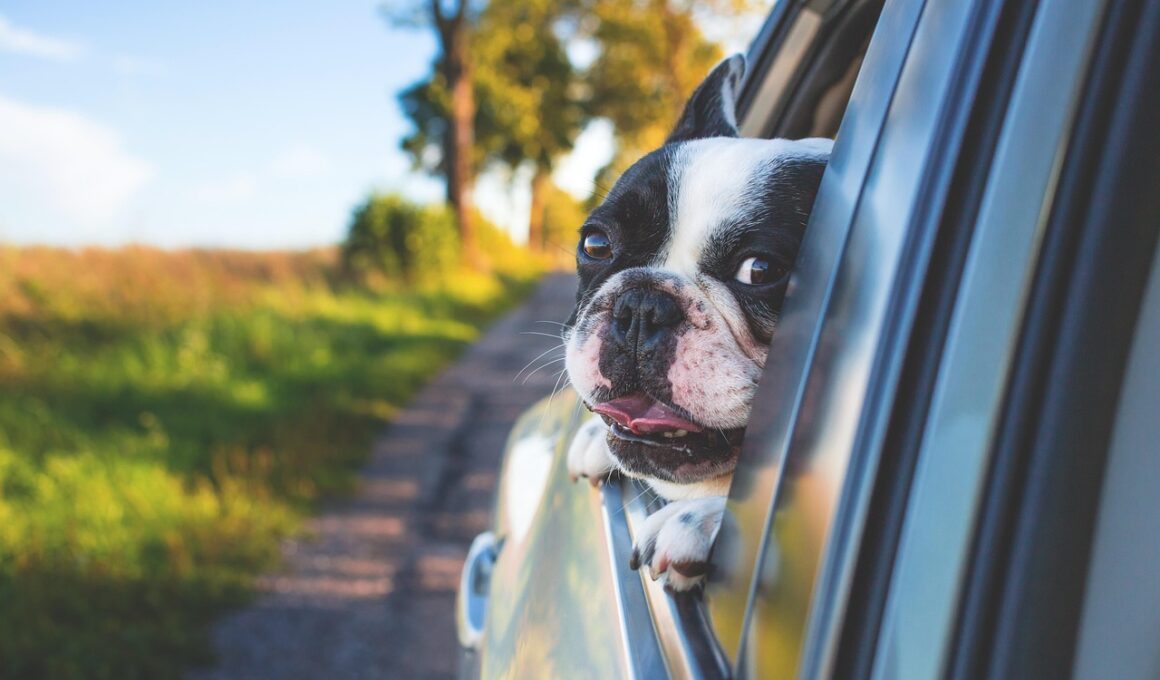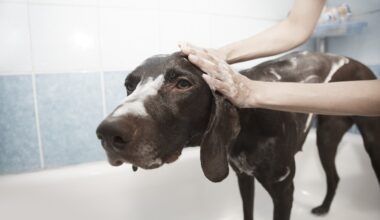Road Safety and Preventing Dog Accidents Outdoors
Ensuring the safety of your dog while out on the road is crucial. Every year, numerous accidents occur due to lack of awareness. Understanding how to minimize risks is essential. Always use a proper leash when walking your dog near roads. A short leash allows better control compared to a long one. Teach your dog to stay close to you and avoid wandering. Make sure to train them to respond to commands like “stay” and “come.” These commands could save your dog’s life in critical situations. Additionally, consider using reflective gear for evening walks. It allows drivers to see your dog more easily and reduces the chances of accidents. For their safety, avoid walking near busy roads during peak traffic hours. This will not only ensure their safety but also provide you peace of mind. Lastly, always supervise your dog and be aware of your surroundings. Being attentive means you’ll notice potential hazards before they become a problem. Road safety requires vigilance, reflection, and proactivity on your part. Your dog relies on you to keep them safe outside.
In addition to direct road safety practices, understanding local traffic signals and their significance can greatly enhance the safety of your walks. Familiarizing yourself with pedestrian signals will help in guiding your dog at busy intersections. Use these signals to wait before crossing. Dogs often get distracted by other animals or smells, increasing the risk of unexpected behavior. Teach your dog to sit and stay while waiting for the signal to change. Furthermore, remain aware of vehicles, motorcycles, and bicycles that may be approaching. Always walk on sidewalks to keep a safe distance from traffic. If there is no sidewalk available, make sure to walk facing oncoming traffic, and be cautious. Stay alert for vehicles backing out of driveways, or turning corners. The unpredictability of other road users emphasizes the need for constant supervision of your pet. Ensure your dog’s collar and identification tags contain updated information. If they get loose during an outing, it will help in their safe return. Remember to vet the areas where you regularly walk your dog for any high-risk locations. Knowledge empowers decisions that improve safety for you and your furry friend.
Emergency Preparedness
Accidents can happen, regardless of how careful you are while out walking your dog. Preparing for emergencies in advance can mitigate anxiety and lead to faster responses. Carry a basic first aid kit specifically for pets when taking them outdoors. This should include items like antiseptic wipes, bandages, and gauze. Understand how to safely use these items by researching beforehand. In an emergency, knowing the nearest veterinarian clinics and their contact numbers is crucial. Keep this information saved on your phone, or written down in a notable spot. Time is of the essence during emergencies; quicker responses often save lives. Evaluate potential hazards in your walking areas, such as aggressive dogs or wildlife. If a situation arises that poses a risk, be well-prepared to safely escort your dog away. In the event of an accident, whether involving another dog or a vehicle, stay calm and assess the situation first before rushing to intervene. Panicking could worsen the incident by causing more chaos. Your poise will provide reassurance to your dog. Remember that prevention is always the best strategy, but preparedness cannot be overlooked.
Installing barriers or enclosures on your property can significantly increase your dog’s safety when outside. If you have a yard, ensure it is completely fenced to prevent your dog from running into traffic or wandering off. Regularly inspect the fence for any damages or openings that your dog could escape through. If they tend to dig, consider burying the bottom part of the fence a few inches underground to prevent tunneling. Additionally, it’s important to train your dog to respond promptly to commands. Teaching recall commands, such as “come” and “leave it,” can be lifesavers. Practice these commands regularly, especially in less controlled areas. Socializing your dog with other dogs and people helps them adapt to various situations, reducing their anxiety and reactive behavior outdoors. If possible, consider enrolling them in obedience classes to solidify these skills. Being confident around other animals and people makes excursions more enjoyable. Implementing these measures creates a safer outdoor experience for your dog. Connecting with local dog owners, trainers, and veterinarians also fosters a positive community focused on pet safety.
Understanding Your Dog’s Behavior
A comprehensive understanding of your dog’s behavior is essential for mitigating accidents while outdoors. Each dog has individual personalities and may react differently in novel situations. Pay attention to signs of anxiety or excitement, as these could indicate potential risk in specific environments. If your dog is easily startled or overly energetic, adjust your walking routes accordingly. Keep a close eye on signs of discomfort, such as barking excessively or trying to flee. Addressing these behaviors early on will help you manage their reactions outside. Factor in your dog’s breed traits, as some breeds may be more predisposed to certain behaviors. For example, hounds may have a stronger prey drive than others and can become fixated on smaller animals. Understanding these behaviors allows you to predict actions and respond accordingly. Use positive reinforcement techniques for desirable behaviors when you are outdoors. Rewarding good behavior encourages continued obedience. These connections build trust and help prevent accidents. Remain vigilant while walking, as crowds, other dogs, and sounds can often stimulate unexpected reactions. Your attentiveness plays a pivotal role in successfully navigating these challenges.
Celebrating your pet’s milestones during outdoor adventures plays a vital role in their overall well-being too. When visiting new locations, reward their good behavior with treats or extra playtime as positive reinforcement. This creates an association between a pleasant experience and outdoor activities. Such positive memories keep them excited about their next adventure, which can ease anxiety. Make it a routine to explore safe, dog-friendly parks or hiking trails, promoting both physical activity and mental stimulation. Diverse sensory experiences enrich your dog’s life and encourage socialization with other dogs. Document these experiences and consider sharing your favorite outings with fellow dog owners online. This not only promotes your pet’s journey but can also help other dog owners looking for new ideas. Remember to respect other pet owners’ boundaries, including refraining from approaching their dogs without permission, ensuring an enjoyable experience for all involved. Dog parks are great venues to celebrate milestones as they allow for safe socialization. Nevertheless, stay vigilant to avoid potential conflicts. If your dog enjoys swimming, private beaches or dog-friendly lakes can also be rewarding alternatives to traditional walks. Efforts to celebrate engagements outdoors make exercise enjoyable.
Conclusion
In conclusion, promoting road safety and accident prevention for your dog outdoors involves multiple facets. Engage in proper training, create a safe environment, and be proactive in recognizing potential dangers. The combination of awareness and preparedness will provide a more secure experience for your dog, helping to diminish risks significantly. Investing time in researching local traffic laws as well as dog-friendly establishments establishes a solid foundation for a delightful outdoor experience. Shape your dog’s social behavior by engaging with other dogs in controlled settings and gradually introducing them to various experiences. Consistent communication and bonding time enhances trust, helping to curb impulsive actions. As responsible pet owners, we must also ensure that our attire is visible when walking in low-light conditions. It is about you and your dog working as a unit to navigate the outdoors safely. Adapting walking habits according to your dog’s behaviors and preferences can further enrich the bond you share. Ultimately, the goal is to cultivate a positive and safe environment where both you and your furry friend can explore without danger or anxiety.
By implementing these comprehensive safety tips and strategies, you ensure your dog’s well-being while enjoying outdoor adventures. The emphasis on awareness, proactive measures, and behavioral understanding allows you to manage the inherent risks that come with outdoor excursions. Whether it’s a casual stroll around the neighborhood or an exciting day at the park, every outing holds the potential for learning experiences and joyful interactions. Prioritize your dog’s safety and happiness while embracing every opportunity to stimulate their senses through novel experiences. Keep pushing boundaries and furthering engagement with the outdoors provides immense benefits for both dogs and their owners. With commitment and consistency, you can create a wonderful and enriching life for yourself and your furry friend.


